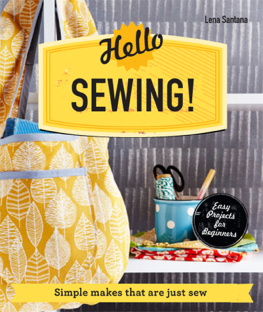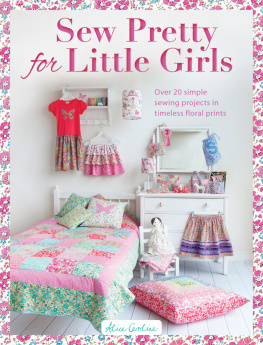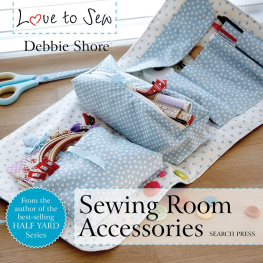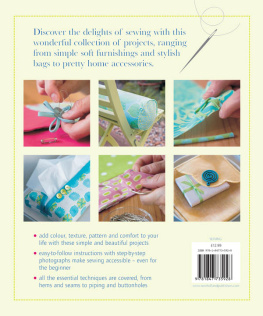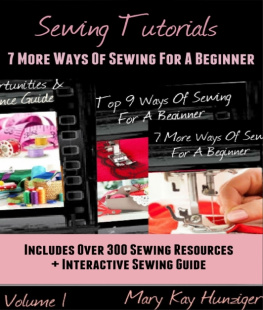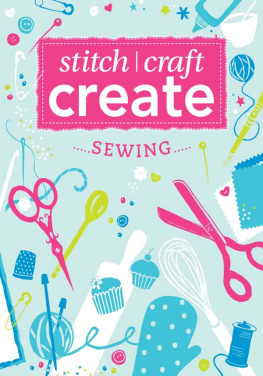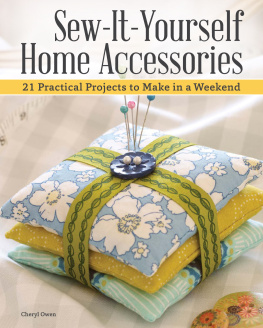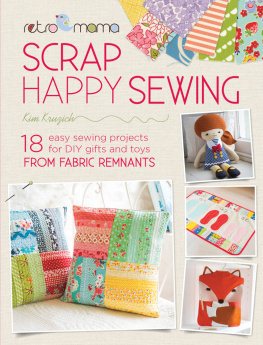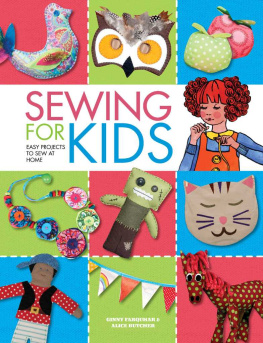


Contents

Fabrics
The secret of producing a long-lasting and wearable garment is all down to the fabric you make it in. Each fabric gives a garment a different feel and form of drape, and it is vital to know which fabrics are most suitable for the type of garment you plan to make. Choosing fabric can be hard if you do not know what to look for, so spend time browsing in fabric shops and do not be ashamed to ask questions. Take your time to learn and appreciate the qualities of different fabrics. You will quickly become entranced by all the beautiful colours, patterns and textures on display. Fabrics come in different widths: the most commonly available are 112114cm (4445in), 140cm (54in) and 150cm (60in).
I love to use fabrics made from natural fibres, such as cotton, linen and silk, and most of the projects in this book are made from these fabrics. There are many places to look for fabrics: dress fabric shops, furnishing fabric shops, remnant specialists, online retailers and market stalls. Im also very keen on recycling fabric, and for projects that include small pieces of fabric, such as for a pocket or trim, you may be able to reuse old blouses and dresses.
Cotton
A natural fibre. Cotton is a strong, absorbent fibre and cool to wear. Pure cotton is made into a wide variety of fabrics of different weights and finishes; it may also be mixed with other fibres, for example polyester cotton. Cotton voile is a soft, light, gauzy fabric used for blouses and dresses. Cotton lawn is a very fine, smooth, lightweight fabric. Cotton satin has a sheen on the right side.
Silk
A natural fibre. Silk fabrics range from filmy georgette to heavier weights such as silk doupion (also known as dupion). Silk satin is soft with a satiny sheen, and drapes extremely well. Silk crpe has a surface texture, drapes well and is ideal for dresses and blouses. Silk is an expensive fabric; many types are dry-clean only, but others can be hand-washed in lukewarm water with a special mild detergent. Dry away from sunlight.
Linen
A natural fibre. Linen is very strong and absorbent, and cool to wear; however, it creases easily. It is made in a range of weights from fine, smooth fabrics to heavy, textured weaves.
Wool
A natural fibre. Wool fabrics come in various weights, finishes and textures, from a gauzy voile to suit and coat weights. We generally think of wool as good for providing warmth in winter, but a fine wool fabric is cool to wear in the summer. Washable wools should be cleaned with a special mild detergent, at a low temperature.
Polyester
A man-made fibre. Polyester fabric is very strong and resists creasing, but is liable to pill and can build up static electricity when worn, causing it to cling. Manufacturers can heatset it into permanent pleats. It is often blended with other fibres such as cotton and wool.
Nylon
A man-made fibre; also known as polyamide. It is lightweight, strong and durable, and does not shrink. It is often blended with other fibres such as wool and viscose. Nylon fabrics are used for clothes, furnishings and other textiles.
Viscose
A man-made fibre created from wood pulp or cotton waste. It is inexpensive and not very strong. It is woven into a variety of fabrics, and may also be blended with cotton, wool or acrylics.
Equipment
You only need a small selection of basic equipment to make the projects in this book. The most expensive item you need to invest in is a sewing machine, but think how much enjoyment youll get out of it in years to come. Buy the best machine that you can afford, and it is sure to serve you well.
The patterns are printed at a small scale and you will need to enlarge them. To do this, you will need squared paper, a ruler and pencil and scissors for cutting paper. See .
Your sewing box should include a tape measure, dressmaking scissors, safety pins, needles and pins, tailors chalk or erasable fabric marker and an unpicker (for unpicking stitches).
Haberdashery
Start collecting trimmings such as braids, ribbons and lace that inspire you. That way, you can build up a wonderful collection for future projects. Also, keep an eye out for unusual buttons.
Every project requires sewing thread: buy colours to match or contrast with the fabric depending on the effect you are trying to achieve.
Many projects use elastic as a quick and convenient way of gathering fabric into a shape; it is also comfortable to wear. It is available in different widths. Elastic thread is used for .
Bias binding is a narrow strip of fabric, cut on the bias. It is used to bind the raw edge of a seam and is available in cotton, polyester or satin, in different widths. Some of the projects use bias binding as a feature, in a contrasting colour to the fabric such as the edging to a waistline or neckline, or a trim around a pocket. It is also used on interior seams to provide a neat and stable finish that stops the fabric fraying.
Making the projects
At the beginning of each project there is a list of the techniques you will need to use and the pages that describe them. The patterns for the projects appear on the pages after the step-by-step instructions.


Seams
French seam
A French seam is one that encloses the raw edges of the fabric within the seam, so there is no need to finish the edges of the seam to stop them fraying.
Place the fabric with wrong sides together. Stitch a seam 10mm (in) away from the edge. Trim to 3mm (in) and press the seam open.
Fold the fabric back on itself, so the right sides are together and the stitched seamline is on the edge of the fold. Press.
Stitch a second seamline, 6mm (in) away. Press the seam to one side.

Clipping curves
To reduce bulk and make sure that a curved seam lies flat, little cuts are made in the seam allowance. The seam allowance of a concave curve for example on a neckline or armhole is clipped to just above the stitching at regular intervals. For a convex curve, cut tiny, triangular notches out of the seam allowance, to just above the stitching, about 12mm (in) apart. This will ensure a smooth and flat result when you turn the seam right side out.

